Congolese Protest
Downing St, London. Sat 30 Jun 2012
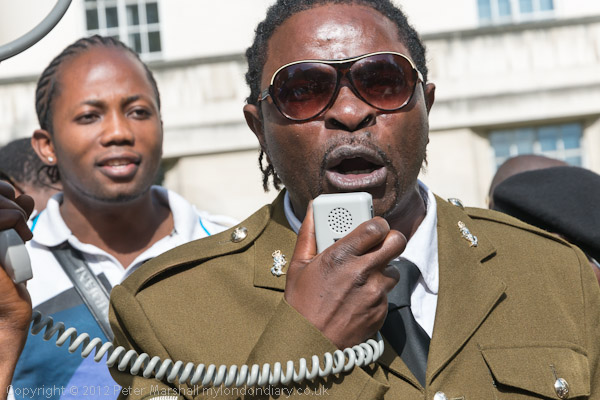
One of several people at the protest in military dress
more pictures
Congolese people marched in London to a rally at Downing St calling for a stop to the genocide, war, murder and rape in the DRC where 8 million have died in wars for the control of the minerals essential for mobile phones and electronic devices.
International Congolese Day, June 30, is the anniversary of independence from Belgium in 1960, and as in previous years was marked by a demonstration in London organised by International Congolese Rights (ICR) whose chairman Albert Mukendi was present wearing a sash in the blue, yellow and red of the Democratic Republic of the Congo (DRC) flag.
The DRC is one of the largest countries in Africa and has vast resources of vital minerals, notably coltan, an ore of niobium and tantalum which is essential for the production of mobile phones, notebooks and other electronic devices. Competition by multinational companies for these scarce and unique resources has been behind the wars that have raged across the DRC more or less constantly since independence, resulting in around 8 million deaths.
Although the 2nd Congo war which began in 1988 officially ended in 2003, fighting still continues, particularly against the 'Mai Mai' rebels who are opposed to President Kabila. Kabila was widely beleived to have lost the election in December 2011, but the government lost the results from thousands of polling stations where the rival candidate had a strong majority.
The Mai Mai commander, Colonel Albert Kahasa has stated that his forces will oust Kabila before September, and has promised that his forces will had over power to the population. They and the protesters in London say that Kabila has made the country - its motto ironicaly "Justice - Paix - Travail" - into a place with no justice and a high level of human rights abuses, one of the worlds most violent places, and one of the poorest in the world, with high levels of disease and little or no health or education services. A comment on a web site to a recent Reuters story about the Congo by a resident of the US calling himslef 'Real Congolese' put it simply:
"Jozeph alias Kabila KANAMBE has killed millions of children and men and women. His days are numbered. He made Congo the poorest country on earth while stealing from congolese people ;no food,no electricity nor real education except killing. No paved roads or freedom of speech. May God listen to Congolese cries and give them a better leader who is a citizen of Congo."
As with some other Congolese protests I've attended there was a considerable
level of heated discussion between those taking part, in particular between
those in military or para-military dress and the political leaders.
more pictures
Sudanese march in London
Downing St to Sudan Embassy, London. Sat 30 Jun 2012
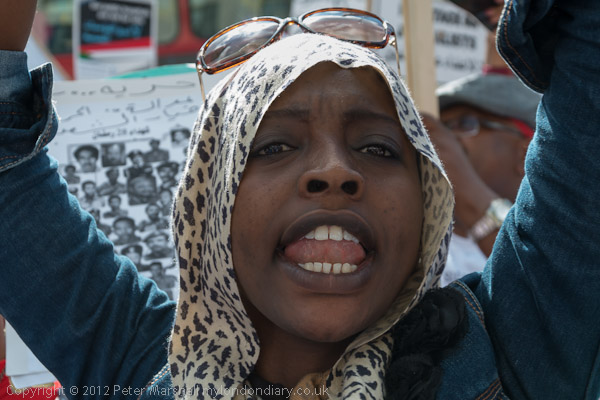 There
was a large and noisy protest opposite Downing St and then they marched to
the embassy
There
was a large and noisy protest opposite Downing St and then they marched to
the embassy
more pictures
On the anniversary of the 1964 coup in which President Bashir took power, Sudanese people protested against the continuing violence in their country demanding democratic change and an end to the Bashir regime with the release of political prisoners.
Peaceful protests have been taking place in Khartoum against the regime since June 16, calling on President Omar el-Bashir to step down. They have been violently dispersed by police, and many of the protesters have been arrested. This has resulted in calls for mass solidarity demonstrations there and worldwide on June 30, the anniversary of the coup by which Bashir came to power in 1964.
The protests have been precipitated by high inflation, particular the rises in the price of food and petrol, where the previous fuel subsidies have been removed as the majority of Sudanese oil reservers are now in South Sudan.
There were perhaps approaching a thousand Sudanese opposite Downing St when I arrived, and they were calling for peace in Sudan where the Sudanese Armed Forces are still carrying out indiscriminate bombing in Southern Kordofan and the Blue Nile states, killing and injuring many and resulting in more than 500,000 fleeing for their lives, including around 150,000 who have sought refuge in Ethiopia and South Sudan. They all want Bashir to go and were calling for the setting up of democracy and for the release of all political prisoners.
At around 4.15pm they left to march to the Sudanese embassy opposite St James's Palace where they continued a noisy protest, and after a few minutes I left them. more pictures
Missiles Out Of East London
Bethnal Green to Bow, London. Sat 30 Jun 2012
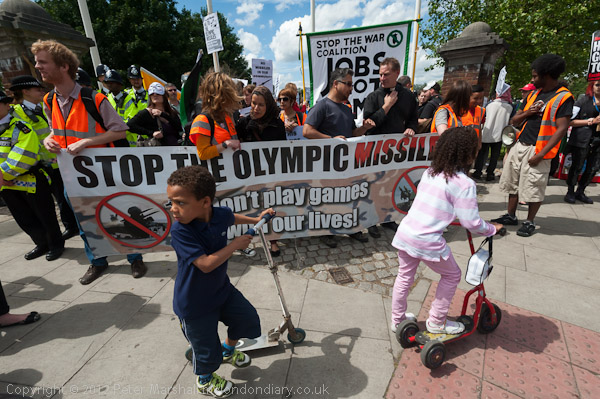 The
march started with a short rally on Wennington Green
The
march started with a short rally on Wennington Green
more pictures
Protesters marched from a rally in Bethnal Green to the Bow flats where the Ministry of Defence is planning to place surface-to-air missiles on a tower overlooking the the Olympic site, demanding that the plans be scrapped.
Although the protest against the siting of missiles in the East End had attracted considerable media attention there were rather fewer protesters at the rally on Wennington Green than expected and a little under 200 who later marched to a brief protest outside the 'Bow Quarter' flats in the converted Bryant and May match factory.
Former Bow Quarter resident Brian Whelan who has been kicked out of the gated residential development for going public over placing the missiles there spoke both at the rally before the march and outside the flats. Other local residents who spoke included Chris Nineham of Stop the War, teacher Amanda Bentham, who brought the support of the local NUT, Rev Alan Green, Abjol Miah of Respect. Other speakers brought support from South London Against Missiles, opposing the siting of missiles at Oxleas Wood and Blackheath, and a solicitor from the group in Walthamstow who have taken legal action against the MoD over missiles on Fred Wigg Tower, as well as speakers from Unison, East London CND and Lindsey German from Stop the War.
Those living in the East End see clearly the dangers of any use of missiles
in this highly built-up area, where interception of any aircraft would cause
damage on the ground over a wide area killing many people. As they marched
the protesters chanted against the people of East London being seen as expendable,
as a suggestion that the government consider 'collateral damage' to the East
End as somehow acceptable.
more pictures
Walking to Waterloo
Southwark, London. Fri 29 Jun 2012
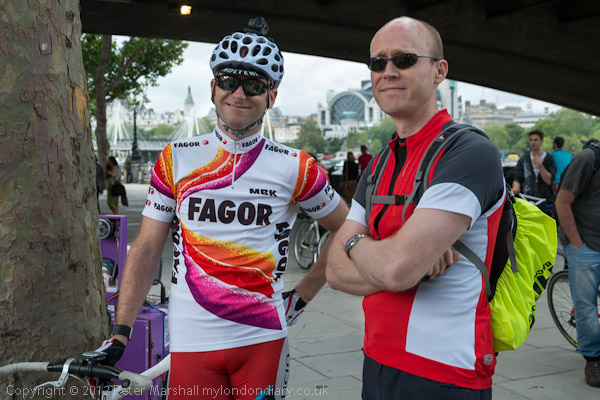
I walked past the cyclists waiting for Critical Mass to begin
more pictures
I had to wait almost an hour before I could take the train home, so I walked across the Millenium Bridge, photographing the view of Blackfriars station and downstream towards Tower Bridge, as well as a large model of a human torso in front of Tate Modern and the new development behind.
It was the last Friday of the month and so Critical Mass was gathering
for its normal ride outside the National Theatre. I was sorry I hadn't brought
my bike up to the city or I could have joined them - perhaps next month when
I suspect they will have greater than usual problems with the police as the
Olympic crackdown will be more fully in place.
more pictures
Cleaners Sacked At RBC
Royal Bank of Canada, Queenhithe, London. Fri 29 Jun 2012
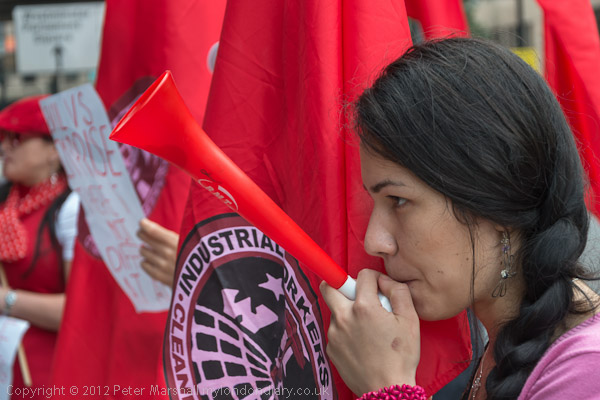
The protest by the cleaner's branch of the IWW was a noisy one
more pictures
Cleaners protested at the Royal Bank of Canada after contractors Emprise sacked the entire workforce for joining the IWW to fight against redundancies, increases in workload, sexual harassment, intimidation and demand the London Living Wage.
The cleaners, some of whom have worked at the RBC for more than five years, were all sacked with effect from today after they joined the IWW trade union and began to stand up for their rights. They are employed by the contract cleaning company Emprise to which the RBC and other occupants of the building - on the outside listed as RBC Capital Markets, Longview Partners, Rabobank and C B Richard Ellis - have outsourced the cleaning.
In February the cleaners in the building were promised the London Living Wage, but it has not been paid to them. They have been threatened by redundancies and there have been apparently ridiculous demands made on them in terms of workload - as an example they say that the work previously covered by 5 people each working a three hour shift is now expected to be carried out by one worker in a single 3 hours of work.
They have also made serious accusations of sexual harrasment, including actual sexual assault by one of the supervisors on a woman cleaner, and say that Empire failed to investigate propersly and dismissed the claim when a formal complaint was made. The cleaners also claim that Emprise's response to complaints of any nature has always been one of severe intimidation of the person making the complaint.
The cleaners felt that their previous union, the GMB, had failed to take action on their behalf and so they decided to join the IWW, which has shown itself to be effective in campaigning for the rights of cleaners in other London offices.
Around a dozen cleaners and supporters arrived for the start of the protest as workers from the building were beginning to leave for home, and a few more arrived later. A few came to watch but still felt too intimidated to take part in the protest.
The cleaners chanted slogans noisily and then made a truly deafening noise blowing on plastic horns, making their presence felt to everyone in the building. Many cars and lorries passing on the busy street joined in by sounding their horns. Quite a few of the workers leaving the building took the leaflets about the dispute, though some others hurried past refusing them.
Police came briefly and asked the protesters to ensure that there was a passage kept clear along the pavement, and after talking with the protesters and the building security soon left. Like all the IWW protests this was a lawful if very noisy event.
There were a few short speeches by Alberto Durango and other IWW union representatives
explaining how the cleaners had been treated and why the protest was taking
place. Around 6pm, when most of the workers had left, the protesters decided
to leave, but before doing so they chanted very noisily that they would return,
again and again if necessary, until the cleaners were reinstated and their
complaints properly dealt with.
more pictures
No to Torture Vigil
Trafalgar Square, London. Tue 26 June 2012
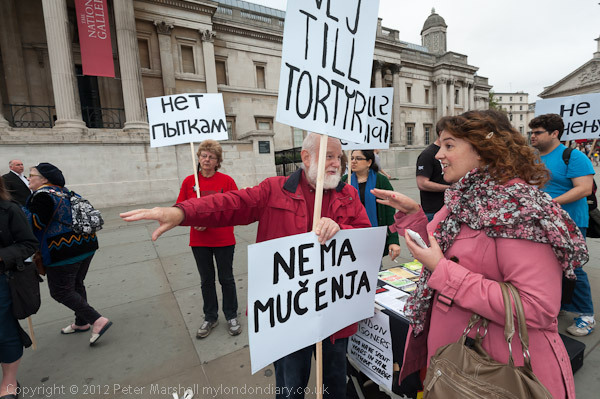 A
Spanish woman talks to the protesters in Trafalgar Square
A
Spanish woman talks to the protesters in Trafalgar Square
more pictures
On the International Day in Support of Victims of Torture marking the 25th anniversary of the UN Convention against Torture the London Guantánamo Campaign held a vigil in solidarity with victims of torture all over the world in Trafalgar Square. The United Nations Convention against Torture and Other Cruel, Inhuman or Degrading Treatment or Punishment came into force internationally on 26 June 1987, and in 1998 the UN declared the 26 June of every year to be the International Day in Support of Victims of Torture.
Supporters of the The London Guantánamo Campaign and other human rights activists held up placards saying "NO to torture" in over 30 languages. Other protesters against various human righs violations joined in the protest, including campaigners calling for an end of the Iranian executions of the Baloch people, those against the extraditions of Babar Ahmer, Talha Ahsan and others to the US and the Free Mumia campaign.
The signs in different languages attracted the attention of the many tourists in the square who came to see what the protest was about, and were pleased to find their own language among the more the 30 on display.
Speaking for the London Guantánamo Campaign, Aisha Maniar said:
"After the horrors of World War II, the world said "never, never again", but it quickly changed its mind. Instruments like the Convention Against Torture and the European Convention on Human Rights were introduced to make states honour the obligations they signed up to, but the failure continues, particularly on this most basic of rights, to protect the most vulnerable in society.
"In the twenty first century, a pernicious new angle has been added to the practice of torture: outsourcing through extraordinary rendition, an international crime almost all states have played a part in. As well as standing in solidarity, we demand accountability for all victims. The demonisation of victims, as asylum seekers, suspected "terrorists" and insurgents must stop; the true criminals, those guilty of crimes against humanity, must instead be prosecuted.
"The twenty-fifth anniversary provides a good opportunity for reflection, one that is unlikely to be taken. The government's recent introduction of the Justice and Security Bill, tipped more in favour of the latter, should not be used as a method of preventing disclosure of involvement in torture and denying victims the right to justice."
The The London Guantánamo Campaign campaigns for justice for all prisoners
at Guantánamo Bay, for the closure of this and other secret prisons,
and an end to the practice of extraordinary rendition. Among those still held
are former London resident Shaker Aamer, whose family live in Battersea
and include a 10 year old son who has never seen his father. Cleared for release
several years ago, he is still detained, probably because his revelations
about torture of himself and others at both Bagram and Guantánamo would
be a serious embarrassment to both UK and US governments.
more pictures
Cleaners at John Lewis
Oxford St, London. 23 Jun 2012
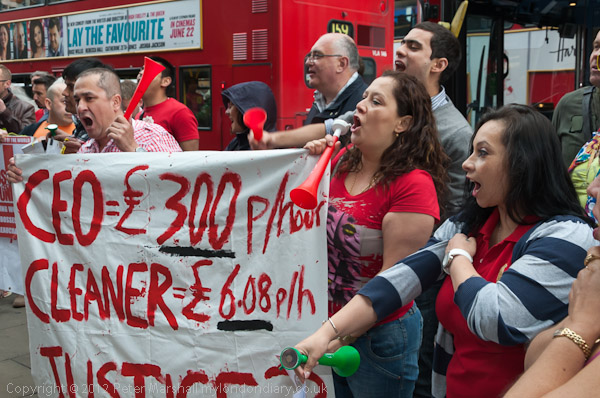
Cleaners shouting outside the store on Saturday afternoon
more pictures
Cleaners held a noisy protest outside John Lewis in Oxford St, demanding to the paid a living wage and to be treated on the same terms as the other workers there who are 'partners' rather than being outsourced second-class workers.
John Lewis is often praised as an employer for its treatment of staff, who are 'partners' and share in the profits of the company. But the cleaners who clean their building are not included in the John Lewis partnership and are treated as second-class workers. Although they work in the same building and are an essential part of the enterprise, their work is out-sourced and they are employed by a contractor, Integrated Management Cleaning.
Some of the cleaners have to work very long hours, starting at 6.00 am and working until 10pm at night. They are paid on the minimum wage of £6.08 per hour, well below the London Living Wage judged by the Greater London Authority as the minimum needed to live in London. They are not paid for all the hours they are available and complain that they are not provided with the proper equipment or protective clothing to do the job.
The cleaners also claim that they experience discrimination from their managers. Hindu cleaners have been called 'bloody Indians' and some other employees say they have been called 'pig heads'. Currently the cleaners in the store are under threat of redundancy, having been told that half of them will be made redundant but that the remaining half will be expected to cover the whole of the work on the same number of hours and no extra pay.
John Lewis last year made £393 million in operating profits and created 4,400 new jobs, but ignores its responsibilities towards the cleaners, employing another company to treat them shabbily. Many of the cleaners are members of the IWW who organised this protest, and they were also demanding union recognition for the IWW.
As shoppers thronged Oxford St on a Saturday afternoon, the cleaners began
a very noisy protest on the pavement outside the main door of the store, blowing
on horns and whistling loudly between speeches. Among those supporting the
protest, which had attracted more than a hundred supports by the time it ended
were Labour MP John McDonnell, who held the banner, helped in handing out
leaflets and spoke in support of the cleaners' claims. There were other speakers
including IWW Cleaners Branch secretary Alberto Durango and one of the John
Lewis cleaners as well as a student leader and other trade unionists from
the IWW and other unions.
more pictures
Climate Siren's Royal Protest
Buckingham Palace, London. Sat 23 Jun 2012
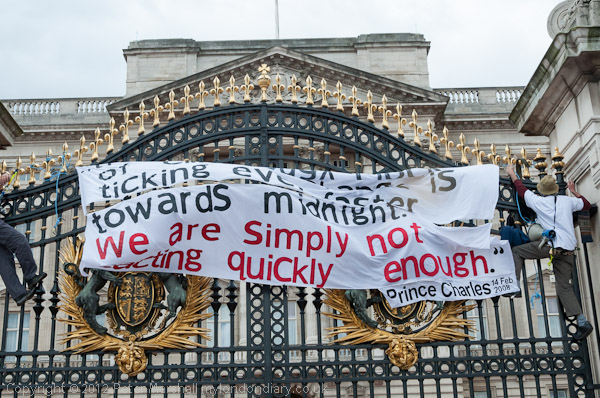 Climate
Siren activists on the palace gates with a banner
Climate
Siren activists on the palace gates with a banner
more pictures
Climate Activists locked themselves to the top of the gates of Buckingham Palace and displayed slogans including a quote from Prince Charles calling for greater urgency in combating climate change in response to the failure of the Rio Earth Summit.
'Climate Siren' protesters scaled the gates of Buckingham Palace this afternoon with banners in protest at the failure of the Rio+20 Earth Summit. When I arrived, there were a pair of protesters locked to the top of each of the two tall ornate gates in front of the palace, holding banners across each of them. On the bottom of the largest banner was a quote from Prince Charles, who talking about climate change on 14 Feb 2008 said "We are simply not reacting quickly enough."
I got to the palace shortly after the 4 protesters had scaled the gates and locked themselves on. Police were holding back the crowd of tourists and a few photographers as the protest continued. The 'Climate Siren' protest had been widely trailed in the press and on a web site as "a great effort of civil disobedience" for today, but without any details as to what it would be or where. Late on Friday evening a Twitter post from 'Climate Siren' had given a time for those who wished to take part to meet at Euston station, and I travelled down to the event with the small group I found there, running ahead the last few hundred yards when I saw what was happening on the gates. These protesters had brought a large banner which they fixed on the barriers facing the palace in front of the Victoria Fountain.
As I was photographing the protesters on the gates one of the officers reached up and grabbed the bottom of the large banner, managin to tear off the small part naming Prince Charles under his quotation. Encouraged by this he climbed further up the gate and grabbed the whole bottom half of the banner with the Prince's text and pulled on this. It gave way and he lost his hold, falling to the ground. Fortunately the bottom on which he landed was well padded and he rolled over having hurt little but his pride.
One of the protesters on the top of the gate was Phil Thornhill, the coordinator of the Campaign against Climate Change, and he had taken a megaphone up with him, so was able to tell the crowd of tourists who were watching what the protest was about and why it was necessary. In between speaking he used the megaphone as a 'climate siren' by generating some extremely loud feedback.
I left the protest roughly half an hour after it had begun and there was
still no attempt being made to remove the protesters, with a small police
presence simply watching them. It wasn't clear if they were waiting for a
specialist cutting team to remove the protesters or simply waiting until they
got bored and came down of their own accord. They did however say that the
protesters who had climbed the gates would be arrested, and suggested that
others involved, including the legal observers who had come with the protesters
- and even the photographers - might also be charged. But perhaps the officer
speaking was simply rather frustrated and having been outsmarted by the protesters.
The four climbers were however arrested.
more pictures
Fathers Day Vigil for Custody Deaths
Brixton Police Station, London. Sun 17 Jun 2012
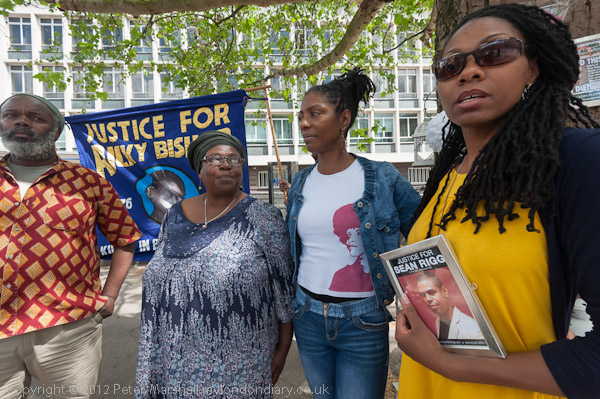
Family members call for Justice for Ricky Bishop, Justice
for Sean Rigg
more pictures
Families of men killed by police held vigils on Father's Day outside police stations across the country. At Brixton, the family of Ricky Bishop was joined by the sisters of Sean Rigg, whose inquest 4 years after his death there is currently in the news.
Samantha and Marcia Rigg brought photographs of their brother Sean, killed inside Brixton Police Station on 21 August 2008, framed them and nailed them to the memorial tree outside the station. The inquest, which began on 11 June is continuing and expected to last six weeks. It will bring into the open an appalling story involving both police and the IPCC in misleading the family and press, covering up rather than investigating what happened, failing to properly investigate and destroying evidence.
The most vital evidence is of course the CCTV footage of the yard where Rigg acquired the injuries to his face that the family only discovered when after over 40 hours their requests to see his body were finally granted. Police first told them that there was no CCTV camera, but then being taken to see the scene were told it had not been working at the time. It remains to be seen whether the police will find and release the video for the inquest or if it has been destroyed.
Police failed to take the normal steps to investigate the area where Riggs death occurred, and the arresting officers were only questioned by the IPCC eight months after the event. Today I heard that the custody suite - which the inquest jury were expected to visit to help them understand some of the evidence - has now been completely destroyed without a proper record being made of it.
Both police and IPCC issued misleading statements about the death - and the IPCC was forced to make an apology. The family have campaigned tirelessy to have his case properly investigated and to find the truth of what happened. As they say, his is not an isolated case, and there are many many others, but their campaign may at last force the police and IPCC to change their behaviour.
Before the start of the inquest the Rigg family issued a statement:
"We have been battling for nearly four years to find out the truth of what happened to our brother that night. Sean was doing great things in his life and it was devastating his life was cut short in this way.
"Sean should have been safe in the care of the police and the mental health services. We believe his death was wholly avoidable and welcome the chance for the evidence to be finally aired publicly and properly scrutinised."
They are now unavailable for comment until the end of the inquest.
The vigil at Brixton was organised by the Ricky Bishop Campaign, remembering another victim of Brixton's Police. They stopped a car in which he was a passenger, claimed that he had a small amount of cocaine and took him to the station. He offered no resistance to arrest or when being held in the police station, but four hours later he was dead. At his inquest the judge denied the jury the option of a verdict of manslaughter. Bishop's family are continuing their campaign for justice, including the arrest and trial for murder of the twelve police officers they name and say were his killers. Pictures of Ricky Bishop were also on the memorial tree which was hung with lanterns containing burning candles, and members of his family and campaign held a banner and sat quietly throughout the three hour vigil.
Towards the end of the vigil a woman came up to the Rigg sisters and told them about her relative who also died in Brixton Police station. She said his name was Colin Bardley and that was beaten to death there around 30 years ago. His was a name new to the campaigners who have a very long list of several thousand deaths in custody. The official statistics are deliberately (if not criminally) misleading and record only a small fraction of such deaths. A report published by the Independent Advisory Panel on Deaths in Custody in 2011 states:
'in total, there were 5,998 deaths recorded for the 11 years from 2000 to 2010. This is an average of 545 deaths per year. Despite the fact there have been 11 unlawful killing verdicts since 1990 there has never been a successful prosecution. '
Sean Rigg's case could be a vital one, in a similar way to that of Stephen Lawrence's. Out of his family's campaign around his killing came the Macpherson Report with its verdict that the Metropolitan Police Force was "institutionally racist" and some action - if not yet enough - resulted. This case may just lead to a similar upheaval in police practice, taking the police towards a greater openess and attacking the incredible conspiracy of the police and legal system to cover up and protect its own.
Among the other vigils taking place on Father's day were those at at Birmingham
West Midlands Police HQ and in High Wycombe for Habib ‘Paps’ Ullah,
Manchester for Anthony Grainger, Slough for Philmore Mills and New Scotland
Yard for Azelle Rodney. In a statement Susan Alexander, the mother of Azelle
Rodney said:
It is now approaching 8 years since my son Azelle Rodney was killed by the
Met Police in April 2005, shot 7 times in the face, neck and back. Over the
years we have cried, campaigned, walked alongside hundreds of other bereaved
families and often alone seeking answers, the truth and justice. We are now
entering into a public inquiry (September 2012). The Fathers Day Vigil is
another opportunity to show a united front... we've got to keep moving on.
more pictures
Hare Krishna Chariot Festival
Hyde Park, Sun 17 Jun 2012
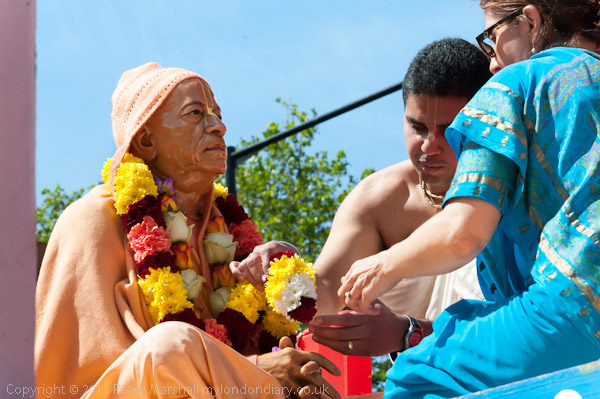
Effigy of A.C. Bhaktivedanta Swami Prabhupada (1896-1977)
the founder of ISKCON (Hare Krishna)
more pictures
A large crowd of Hare Krishna devotees pulled three giant chariots through central London from Hyde Park to Trafalgar Square chanting and dancing in the annual Rathayatra Chariots Festival.
The Rathayatra Chariots Festival in London over the years has grown to be a very large event, with more than a thousand devotees pulling the three giant chariots through the streets from Hyde Park to Trafalgar Square, chanting Hare Krishna and dancing.
Rathayatra started at the Jagannatha temple in Puri, Orissa on the Indian east coast, which was built around a thousand years ago, though the festival may be older. It celebrates the time when Krishna grew up on earth and when he became a great lord moved away from his childhood friends. These cowherds visited him and tried to kidnap him and take him back to their village on a cart.
Three deities are worshipped in the temple at Puri, and each is carried on a chariot. They are Krishna in the form of Jagannatha, his half-sister Subhadra, and Balarama her brother.
Jagannath means 'Master of the Universe' and his name and the chariots in the festival give us the word "juggernaut".
The chariot festival first came to the west to San Francisco in 1967, and
was brought to London by a small group of disciples from the International
Society for Krishna Consciousness (better known as the Hare Krishna) two years
later. An effigy of the founder of ISKCON, A.C. Bhaktivedanta Swami Prabhupada
(1896-1977) is also carried on one of the chariots in the festival.
more pictures
Diggers at Runnymede Call For Freedom
Magna Carta Memorial, Runnymede, Surrey, Sat 16 Jun 2012
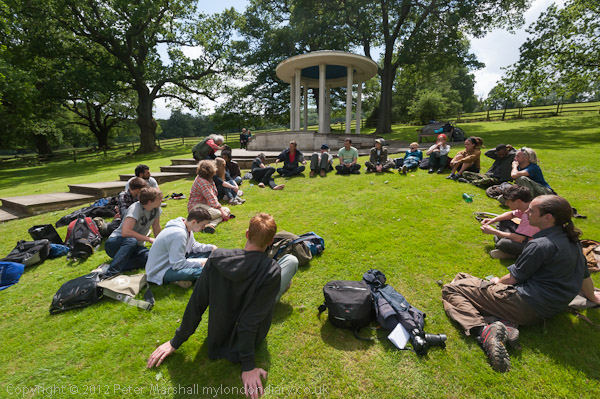
I stepped back a couple of paces from the circle to
take this picture
more pictures
Diggers camped at Cooper's Hill, met at the nearbye Runnymede monument where Magna Carta was signed on 15th June 1215 at to discuss their ideas about freedom and the right of people around the world to shelter and grow food on disused land.
The original Diggers or 'True Levellers' were founded by Gerard Winstanley in 1649 after the first English Civil War and his ideas were based on the relationship between man and the environment; an early ecologist he stated that "true freedom lies where a man receives his nourishment and preservation, and that is in the use of the earth" and that "England is not a free people, till the poor that have no land have a free allowance to dig and labour the commons." They took ideas of sharing of property from the New Testament and they harked back to a time before 1066, when the Norman conquerors took hold of the land and divided it between themselves. Although it is not clear what the situation was before that time, there has been remarkably little change in land ownership over the almost 950 years since then, with the same families still owning the great majority of English land. A minute fraction of the UK population - 0.65% - currently own more than two thirds of the UK land area.
In April 1649 at a time when food prices had risen to unheard of levels, local landowners at St George's Hill in Weybridge (now a very exclusive private estate) called in the army because the Diggers had begun to plant vegetables on common land, and invited others to join them in defying the landowners.
The army commander, Sir Thomas Fairfax came to see what was going on and he interviewed Winstanley and the others, but decided the diggers were not harming anyone and told the landowners to take their case to court. Instead the Lord of the Manor decided to start by employing gangs of ruffians to attack the Diggers, and they beat them up and burnt down a house. There followed a court case not about their use of the land but accusing them of being members of the heretical Ranter sect which abandoned all traditional restraints, embraced immorality and rejected the idea of private property and obedience to laws. It was more a witch hunt than a court case, with the Diggers being refused the right to speak - and some historians now believe that there was never such a movement. Certainly the Diggers were not Ranters, but they lost the case, and this meant that the army could have been used to remove them, and they abandoned their plots in August, around 4 months after they had moved in.
There have been a number of similar occupations and cultivation of disused land in recent years, for example by 'The Land Is Ours' at the Wandsworth/Battersea Guinness site in 1996, and more recently the Kew EcoVillage and Grow Heathrow sites.
A week ago, a small group set out from the Syon Lane Community Allotment hoping to start a community on a disused piece of land on the Crown Estate at Windsor. They had publicised their intentions widely and were accompanied by police and served with injunctions forbidding them to go into Windsor Great Park. When they arrived at the site that locals had assured them had long been disused, the Crown Estate produced someone who told them he was shortly to crop the site which was pretty full of nettles as silage. They moved on and out of the Thames Valley Police area to a temporary site on a riverside park in Runnymede for the night before moving on to woodland owned by Royal Holloway College, part of the University of London, on Coopers Hill. Despite promises by the Diggers to move on at the end of the week, the college applied for an injunction and papers were served on Thursday evening.
The diggers are now on a definitely unused site a short distance away on the actual Cooper's Hill site, which was sold by Brunel University (it had been Shoreditch College) in 2007. This large site is now owned by a property developer who hopes at some time to build 600 eco-homes there, but lack of cash and planning permission mean this is unlikely to happen for some years. The Diggers camp is just to the north-east of the 'Pillar Hall' one of several locally listed nineteenth buildings on the former Runnymede Campus, in the now rather overgrown gardens. Relations between the Diggers and site security men are good after the campers promised not to attempt to enter the buildings. Parts of the grounds are used occasionally for police dog training and it remains to be seen how this might effect the Diggers!
Today's meeting took place at the memorial to Magna Carta erected by the US Bar Association on National Trust Land a few hundred metres north of the camp site (though several times farther by footpath and road.) At the start of the meeting there was a very friendly police officer and a National Trust person present, both of whom contributed some information about the area and the site. We got considerable insight into the area and the historical and current relevance of Magna Carta - as well as the lesser-known but more relevant to the common man 'Charter of the Forest' which was issued shortly afterwards and joined with Magna Carta in 1297 from a lecturer in history from Royal Holloway who took an active part in the discussions of the afternoon.
The Diggers hope to be able to stay on the current site for some time and to use it as a practical example of their philosophy. There was also considerable support among the twenty or so people present for the idea of a popular celebration of the 800th anniversary of Magna Carta at Runnymede to take place as well as the more formal and business-oriented celebrations being put forward by the district council and others. It was also mooted that their might be some annual 'gathering of rights' celebration leading up to this, with mention being made of the Windsor Free Festival that took place nearby in Windsor Great Park in 1972-4, organised by Ubi Dwyer and Sid Rawle. There was a general agreement that something needed to be done to reclaim civil liberties that have been eroded over recent years with various suggestions for action and perhaps a new people's charter.
After a couple of hours of discussion, with some people leaving and others
joining, we walked up to visit the Diggers camp. It was made clear that visitors
are always welcome - especially if they bring some biscuits or cakes or other
supplies - and if you want to stay for a night or more, a tent or sleeping
bag. Once they are clearer about their position they will also need some help
with cultivation and other work on site. The Diggers have a blog at diggers2012.wordpress.com/
which gives information about what is happening and how to find them - and
contact details.
more pictures
Carnival of Dirt
St Paul's & the City, London. Fri 15 Jun 2012
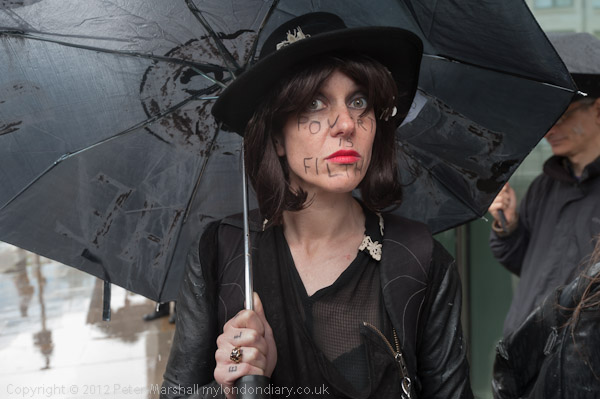
Poverty is Filthy says the writing on the face of this woman in black
more pictures
The 'Carnival of Dirt' united activist groups from the UK and around the world in a funeral procession for the many killed by mining and extraction companies, powerful financial organisations whose crimes are legitimized by the City of London.
More than 30 activist groups from London and around the world met on the steps of St Paul's Cathedral, many dresses in black, to take part in a New Orleans style funeral procession to remember the many activists around the world who have been murdered for standing up against the interests of the powerful mining and extraction companies, many of which are listed on the London Stock Exchange and who trade on the London Metal Exchange. Among the companies named (with links to information about them on the 'Carnival of Dirt' web site) as major criminals were Xstrata, Glencore International, Rio Tinto, Vedanta, Anglo American, BHP Billiton, BP and Shell
Greed for gold and other minerals essential for modern life have led to crimes against humanity on a huge scale around the world. They lie behind the millions who have died in wars in the Congo and elsewhere, behind the torture and rapes and other human rights abuses that are used to drive people off their land, behind the huge areas of land poisoned by toxic wasters, forests and whole mountains destroyed, ecocide on a truly massive scale.
Yet despite these often well-documented crimes, these corporations are propped up by our pensions schemes and protected by our government and even allowed to get away with evading millions (if not billions) of UK taxes.
The funeral cortege that gathered at St Pauls included a large snake, a turtle and a tortoise, a reminder of XStrata's criminal diversion of the McArthur River, destroying the ecosystem and despoiling the sacred sites of Australian aborigines. There were coffins representing the dead and naming many of the companies involved one said 'Glencore Values - Toxic Assets, Toxic Environments', another 'XStrata - X-Rated on Human Rights' and pointed out the CEO Mick Davis "Gets £30 million to stay in job while 2 Dead 80 Injured protesting at Tintaya mine in Chile.' A small coffin represent the over 18,000 child miners in the Phillipines, while another read '10 Million Dead Through Conflict in 16 years equals a 9/11 every 2 days'. A black coffin carried on the side the message 'Resist Corporate Terrorism' and on the top the message 'London Metal Exchange - Setting the Global Standard in Bloodshed' with red drops bleeding from it. Another testified to the genocide in West Papua where Indonesian troops have torched villages.
Many carried placards with photographs of a few of the better-known activists who have been murdered for standing up to corporate terrorism, and marchers distributed a leaflet naming 15 of them - Valmore Locarno, Fr Fausto Tentorio, Victor Orcasita, Alexandro Chacon, Fr Reinel Restropo, Dr Gerry Ortega, Armin Marin, Dr Leonard Co, Elizer Billanes, Jorge Eliecer, Floribert Chebeya, Raghunath Jhodia, Abhilash Jhodia, Damodar Jhodia, Petrus Ayamiseba. Others carried photographs of unnamed and horribly mutilated victims.
Many of those taking part smeared mud on their faces as a gesture of solidarity with the West Papuans, and some wore mourning veils. Also in evidence were many in the by now familiar 'V for Vendetta' masks favoured by 'Anonymous' supporters, as well as a few anarchist-style face scarves.
Chris Knight made a good funeral director, in black and wearing his top hat, but the procession was led in best New Orleans style by a marching band playing many of the funeral standards. After a brief introduction on the steps of St Pauls, they lead the procession towards the Stock Exchange, but their way was barred by security men and barriers at Temple Bar. The coffins were brought to the barrier and there were some brief comments made before the procession moved off back through St Paul's Churchyard, up Ave Maria Lane on to Newgate St and the northern entrance of the Stock Exchange. This was blocked by police while the protesters gathered outside for a short meeting with a speech from Benny Wenda, who as Chairman the Papuan Peoples' Tribal Assembly (Denmak) was arrested, imprisoned and tortured by Indonesian troops but managed to escape to the UK. There were several heavy showers and some of the coffins suffered a little and we all got rather wet. There were quite a few protesters who had volunteered to carry black umbrellas with slogans on them, and although the slogans mainly ran in the rain, these came in handy.
From here the procession moved on to the Bank of England, holding a longer meeting with several speeches from researchers and activists. There was a final stop at the London Metal Exchange where we got a clear exposition of the various trading activities which cause a great deal of death and unnatural disaster across the globe. The names of some of the prominent murdered activists where then read, with the crowd being asked to respond to each by shouting that they were present; this was followed by a two minute silence for them and the many others who have been killed to further the profits of the mining companies, after which protesters threw ashes at the building.
From here the cortège made its way on to Altab Ali park in Whitechapel
where everyone was going to have lunch. The procession had been escorted on
its route by City police, and there were no major incidents, with the protesters
largely following the police requests to keep to the pavements and making
no attempts to enter any premises. In the park there were cheers as Occupy
put up a tent, but the protesters did not intend to remain there, with a protest
near Green Park later in the afternoon and a 'Reclaim the Streets' style party
starting on the Embankment at 6pm.
more pictures
Stop The War - No Intervention in Syria
Downing St, London. Thu 14 June 2012
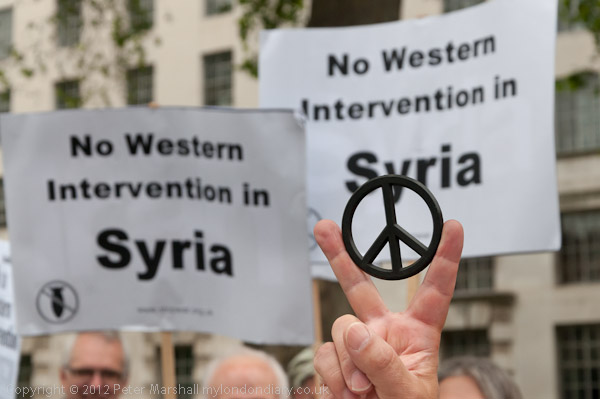
A protester holds up a peace symbol in fingers making a 'V' sign
more pictures
Stop the War held an emergency picket at Downing St and took a letter to the Prime Minister calling for no western intervention in Syria after a statements earlier this week by William Hague that the question of military action remains open.
The protest had been called after former UK foreign secretary David Owen
urged Turkey to threaten to
lead a NATO intervention in to the country and William Hague had said the
question of military action in Syria remained open. Stop the War had contacted
the authorities at Downing St immediately in order to be able to deliver a
letter to the Prime Minister, but had been told that because of the increased
security for the Olympics in a month and a half it was now necessary to give
five days notice in order to be admitted to Downing St.
So when the group of Stop the War officers including President Tony Benn, Chris Nineham, Tony Benn, Sabah Jawad, Lindsay German and Kate Hudson took the letter across to Downing St they were politely refused entry by the police officer on duty. It seemed particularly ridiculous since most or all of those involved were clearly recognised by the officer and could have posed no conceivable threat to security.
The officer did agree to take the letter and make sure it was conveyed to Number 10, but surely it is time for this kind of farcial and unnecessary restrictions which have no conceivable security justification to be sorted out.
The protest was attended by around 50 people, including Jeremy Corbyn MP,
and was an unusually quiet affair, enlivened only by a group of three people
who sang a few anti-war songs. At the end Chris Nineham thanked all those
remaining (many had already left) for attending.
more pictures
LSE Cleaners Protest
LSE, London. Wed 13 Jun 2012
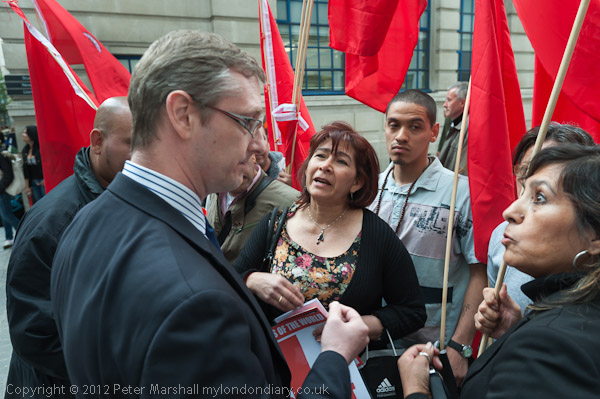
Cleaners tell the LSE Facilities Manager what is happening to them
more pictures
Cleaners in the IWW trade union employed at the LSE under contract to Resource Group protested this lunchtime against cuts in hours and racist bullying. They were supported by LSE students and LSE trade unionists.
In January 2012, the London School of Economics (LSE) gave a new contract for its cleaning to the Resource Group, a company that claims as one of its principles that it "will work to develop our employees and future work force to build healthy lives." According to the cleaners, the company is actually cutting their wages by giving them shorter shifts in which to do the same work, and is bullying them into signing new contracts.
The cleaners feel strongly that they have been let down by the LSE. One of them is quoted as saying 'LSE deceived us because what is the point of paying the living wage if our hours are cut from two and a half hours to two hours.' Another told me they wanted to cut her three hours of work down to two.
Many of the cleaners have Spanish as their first language and although they speak English find it difficult to read the language. Some told me they had been given documents in English which they could not understand changing their hours and other conditions and told they must sign or lose their jobs.
Outsourcing - as doubtless research by the LSE will have shown - almost invariably leads to lower wages and poorer working conditions for the staff involved. And although the cuts and alleged bullying is being carried out by Resource Group, the responsibility for it must lie with the LSE who are responsible for the contract with them.
At the start of the protest, the LSE facilities manager came out and talked briefly with the cleaners, and he seemed unaware of the cuts in working hours and other activities of their contractor. Towards the end of the protest which he was watching, one of the speakers challenged the LSE and him in person, and he spoke very briefly in reply, after which he went to talk to some of the cleaners who made the situation very clear to him.
At the start of the protest a representative of the various trade unions in the LSE - including the university teachers union UCU as well as those representing other staff spoke briefly in support of the cleaners. The protest was also supported by the LSE student's union as well as those from some other colleges of London University including SOAS. Between the various speeches there were rousing performances from the samba band, particularly effective in the narrow streets surrounded by tall buildings of the LSE campus.
The protest ended earlier than planned, so as not to disturb the examinations
that were taking place at the LSE, but they ended with a clear message from
the IWW union that represents the cleaners that they were not prepared to
accept the pay cuts and the treatment of their members as "second-class
employees" and in particular the racist bullying, and the warning "We'll
be back!"
more pictures
Sikhs Remember 1984
Hyde Park, London. Sun 10 Jun 2012
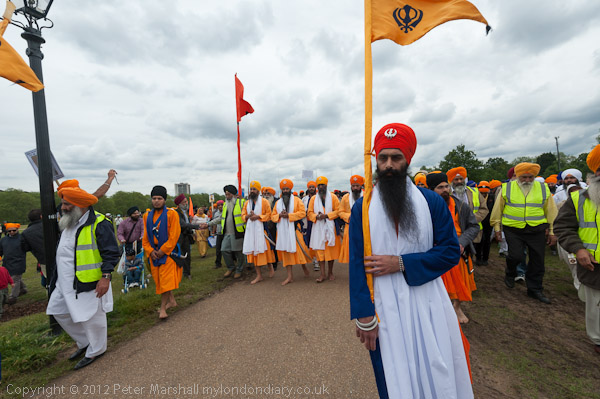
The march sets off led by men bearing the Sikh flag and those carrying swords
more pictures
An estimated 10,0000 Sikhs marched from Hyde Park to mark 28 years since the 1984 Sikh genocide and the destruction at the Golden Temple in Amritsar, calling for justice, freedom for Sikh political prisoners and the establishment of an independent Khalistan.
There was a large crowd listening to speeches in Hyde Park when I arrived shortly after the official start of the event, and people were still arriving in large groups from around the country an hour later. There were a few speakers who translated all or part of what they said into English, but although I could understand little of the rest, the unanimous powerful support for Khalistan was clear, with chants of 'Khalistan Zindabad' (Long Live Khalistan) and raising of fists in support.
Eventually the march began to form up, led by a group of Khalsa marching barefoot; two men in blue robes and red turbans carrying the Sikh standard and a few yards behind five in orange with their swords held upright - the five 'Blessed Ones' (Panj Pyare.) Behind them were a group of mainly young men carrying black coffins, followed by young men and women carrying long poles with black flags, both symbolising the thousands of Sikhs killed in the 1984 genocide and since then.
In 1984 Indian Prime Minister Indira Ghandi ordered the Indian Army to storm the Golden Temple in Amritsar, claiming that Sikh separatists led by Jarnail Singh Bhindranwale were storing weapons there with the intention of beginning a major armed struggle to establish a free Sikh state. The temple was badly damaged and more than a thousand, including Bhindranwale, were killed.
Many more Sikhs were killed in riots following the attack, said by Sikhs to have been part of a planned eradication of Sikhs encouraged by the Indian states. Later in the year Mrs Ghandi was killed by her two Sikh bodyguards in retaliation for the attack on the Golden Temple and this was followed by widespread attacks on Sikhs.
Attacks on Sikhs continued and in particular the Punjab Police under Chief Minister of Punjab Beant Singh acted very forcefully against those suspected of supporting the formation of an independent Sikh state of Khalistan, and was alleged to be responsible for the extra-judicial execution and cremation of tens of thousands of Sikhs (more than 150,000 according to some sources.) He was killed in 1995 in a suicide bomb explosion by police officer Dilawar Singh Babbar and another policeman, Balwant Singh Rajoana was involved in the plot to kill him.
Rajoana, who confessed his involvement and justified it by the discrimination against Sikhs by the Indian government and judicial system, including the 1984 attacks, was sentenced to death by a special court in 2007 along with Jagtar Singh Hawara (and three others were sentenced to be held in jail until their death) and was due to be hung on 31 March 2012. He had refused to defend himself or to have a lawyer or ask for mercy by an appeal for clemency was made by the Sikh Shiromani Gurdwara Parbandhak Committee and the Indian government postponed his hanging.
The Sikh Akal Takht, the highest temporal authority of Sikhism, has named Rajoana as a "Living Martyr" (and Babbar as a "National Martyr." Many of those in todays protests carried pictures of Rajoana and showed their support of the 'I Pledge Orange' campaign, pledging support of humanity, love, peace, unity, equality, justice and freedom and specifically against the execution and called for his release, along with all Sikh political prisoners.
According to Dal Khalsa UK, as well as the death sentence for Rajoana, recent months have also seen "the burning of Sikh Turbans,Threats to Sikhs & the Killing of Sikhs by Shiv Sena,RSS,BJP & Other Hindutva Terrorists Groups - with state support."
I left the march as the end of it made its way onto Piccadilly on its way
to a further rally at Trafalgar Square.
more pictures
Naked Cyclists Ride Against Oil
London. Sat 9 June 2012
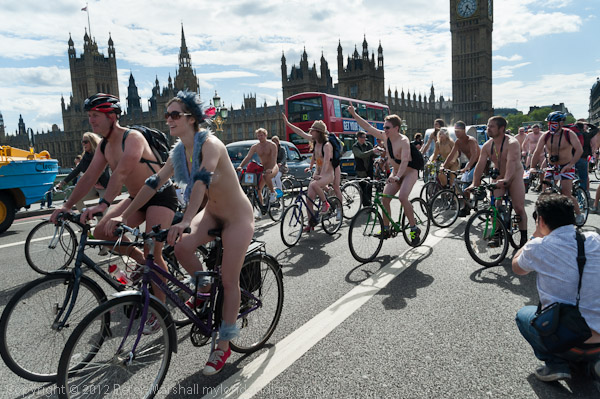
The ride goes over Westminster Bridge
more pictures
Hundreds of cyclists in various states of undress, some wearing nothing but shoes, took part in the World Naked Bike Ride, an annual environmental protest touring central London, much to the astonishment of many tourists.
Despite unseasonably cool weather and a poor forecast around a thousand cyclists turned up for the start of the ride, and unexpectedly the sun came out and it got almost warm as the braver souls stripped off for the ride.
Unfortunately the start was chaotic, partly because of the large number of tourists and others with cameras pestering some of the riders, but also because of the complete lack of traffic control around the busy Hyde Park roundabout which made exiting from the centre island where the ride had gathered extremely dangerous as cyclists had to ride through the traffic on the roundabout and emerging from Knightsbridge and Park Lane on their way to Piccadilly.
Police tried with little success to control the large crowd of watchers who were spilling onto the road. Their efforts would have been far better directed to halting the traffic flow for a few minutes at the start which would have allowed the mass of cyclists to quickly move out and into Piccadilly. It would have caused much less traffic disruption and have been considerably safer for cyclists and watchers.
Fortunately the ride organisers had included a number of points on the ride where it stopped for everyone to catch up, and by the time I met up with it again after it had gone past Piccadilly Circus and Trafalgar Square they made their way down Whitehall almost all in a single mass.
As in previous years the event turned the heads of many on the streets of London, including the usual throng of tourists. It caused a great deal of amusement and interest and not a little scratching of heads as to what the event was about.
Although there had been many earlier naked bike rides organised as naturist or political demonstrations, the first World Naked Bike Rides were organised in 2004 and now take place in many cities around the world. The rides are a protest against dependence on oil and other forms of non-renewable energy and "expose the unique dangers faced by cyclists and pedestrians" in modern cities.
Many of those taking part wear some clothing, and for cyclists the only essential wear is shoes, although many wear more - the dress code is "as bare as you dare." Many also have body paint, sometimes solely for decoration but often expressing an environmental message, contributing to the purpose of the ride to "deliver a vision of a cleaner, safer, body-positive world." As well as the mass of cyclists the event also includes a few skateboarders, in-line skaters and other forms of human-powered transport.
The London ride is one of around 70 which take part annually in 20 countries around the world, including others in Brighton, Bristol, Cardiff, Exeter, Glasgow, Manchester, Portsmouth, Southampton and York. Public nudity is not in itself illegal in Britain, and seems to cause a great deal of hilarity from some onlookers but little or no offence.
I left the ride as it made its way from Westminster Bridge past the back
of the Royal Festival Hall on the South Bank. The planned route of around
8 miles would take it back across the river on Waterloo Bridge and then to
St Paul's via Fleet Street before coming back to Holborn for a circuit of
Lincoln's Inn Fields and on through Covent Garden back to Trafalgar Square,
the Mall and Piccadilly to its starting point.
more pictures
Rally Against ACTA
Europe House, Smith Square, London. Sat 9 Jun 2012
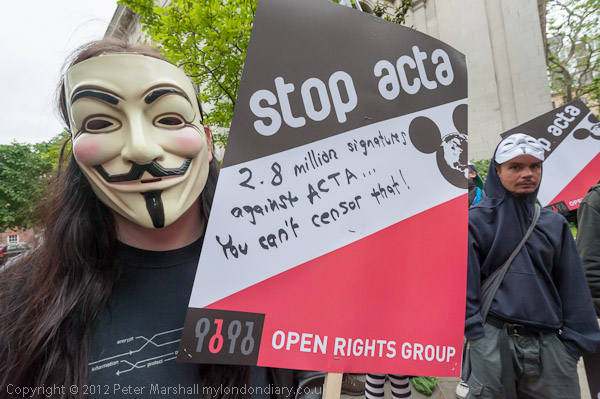
'Anonymous' masked protester with ORG placard against
ACTA
more pictures
Protesters including the Pirate Party UK, ORG and Anonymous rallied outside the European Parliament building in London to persuade MEPs to drop the ACTA proposals which violate fundamental freedoms to police the interests of major companies.
The London protest was one of well over a hundred across Europe from Ireland to Turkey and Georgia as well as in Canada today, with massive protests expected in Eastern Europe following those earlier in the year, although the London one was only attended by a little under a hundred people. Protests in the UK are also against the Digital Economy Act passed with virtually no parliamentary debate in the tidying up process during the final days of the Labour government and which is already being used to force ISPs to block access to some web sites.
The London protest was organised by the Open Rights Group and the Pirate Party (UK) and had not been as widely publicised as the larger event earlier this year. Among those who came were a number of 'Anonymous' supporters wearing 'V' for Vendetta masks, including a number from Occupy London, some of whom are still occupying Finsbury Square despite threats of eviction.
Among the dozen or so who spoke outside Europe House were Pirate Party UK leader Loz Kaye, journalist Glyn Moody, Neil McGovern of the Open Rights Group and a Liberal Democrat who reminded us that theirs was the only one of the three major parties to have already come out against ACTA, and that Lib-Dem MEPs and their allies had been responsible for the defeats that it had recently suffered in European committees. Other speakers also applauded these successes, achieved as a result of the earlier protests, but were clear that it was necessary to keep up the efforts to ensure that the EU does finally reject it. And we were warned that even if this does happen, the corporate interests and their highly paid and organised lobbyists will seek to resurrect the proposals with minor changes and a new acronym.
There were also speakers representing the views of 'Anonymous' and of a Dutch group particularly concerned with the effect that the anti-counterfeit operations were already having on shipments of much-needed generic medicines to majority world countries, where indiscriminate raids had already disrupted some legitimate supplies.
The Anti-Counterfeiting Trade Agreement (ACTA) was put together in secret talks between the USA, Europe, Japan and some other major governments to protect the copyrights, trademarks and patents held by major multinational companies. The negotiations were set up privately to deliberately exclude the views of civil society and developing countries which would be represented in existing channels, and the details of the agreement only became public after they were released by Wikileaks. As well as protecting the commercial interests of high-priced designer goods against 'fake' products, the proposals endanger major health programmes in many poorer countries which cannot afford extremely high cost patented drugs.
It also became clear that ACTA could seriously affect internet freedom, leading to web sites being blocked and the surveillance of private sharing of information. It would mean many individuals would be prosecuted or that individual internet accounts of those who are alleged to have infringed copyright would be blocked, and would greatly inhibit the sharing of information of information across the web. Whole families or organisations would be banned from internet access because of the alleged activities of one individual, without the need for any properly tested process.
Many of those involved in the protest are musicians and other content creators who want to see changes in copyright law that protect their rights, but fear that ACTA may actually prevent or inhibit their ability to profit through distributing their own work via the Internet. They support changes that would preserve the rights and freedoms of others rather than grant draconian powers for the benefit of the major corporations.
Although 22 of the 27 EU countries have signed up to ACTA along with the USA and Japan, the pressure from protests in many countries once the details became known has prevented most of them ratifying the agreement.
Four European Union committees - the industry committee, the civil liberties
committee, and the legal affairs committee and the development committee -
have rejected ACTA, but their decisions are not binding on the International
Trade Committee which is the lead committee on the subject and will come to
a decision on 21 June. The European Commission has referred ACTA to the European
Court of Justice to decide whether it is a violation of Charter of Fundamental
Rights of the European Union, but the European Parliament has refused to delay
its vote for the ECJ's opinion.
more pictures
Devon Holiday
Devon, UK Sat 2-Fri 8 Jun 2012
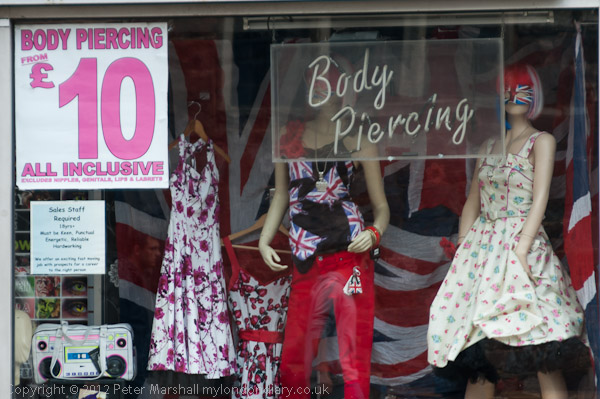
We couldn't quite get away from the Jubilee
Devon isn't London by any stretch of the term, but I spent a few days there
and have put some of the pictures I took online. We were staying a short distance
from Exeter and most of the pictures are from Exeter, Topsham, and a few places
around. They include pictures from two National Trust sites and Exeter Cathedral
which are not available for reproduction or commercial use.
more pictures
No to Colombian Gold Mine
Hans Crescent London. Fri 1 Jun 2012
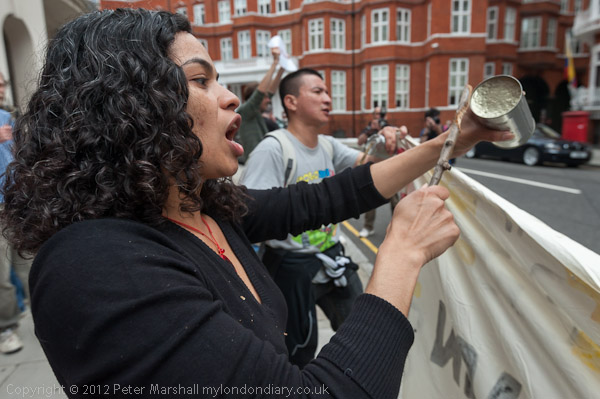
Banging on tin cans opposite the Colombian Embassy
more pictures
Colombians and others protested against AngloGold Ashanti's proposal to mine in AngloGold Ashanti, displacing communities, destroying the ecosystem, contaminating rivers and the cause of human rights violations against the local people.
The mining project by the world's third largest gold producer, AngloGold Ashanti (AGA), which has its headquarters in Johannesburg but is also listed on the London Stock exchange has the backing of the Colombian government but faces strong local opposition in Cajamarca. Colombia is one of the major areas in the world where the company is undertaking exploration. They want to mine low grade porphyry copper deposits which contain a very small amounts of gold, typically 0.5 to 1 gram per ton of ore, a process which involves huge open pit mines and chemical extraction of gold using large quantities of toxic cyanides. These deposits are huge in scale but the ore was too poor a grade for traditional mining techniques.
AGA was one of the first companies to come to Colombia after former president Alvara Uribe permitted exploration in the country, but last year they were joined by most of the major gold producers (or companies owned by them), creating a boom in exploration there. Their major project is at La Colosa in Cajamarca where there are thought to be around 12 million ounces of gold.
Doubts about the environmental impact of mining on this scale at La Colosa were raised last year when it was reported that the mine, expected by AGA to be constructed in 2014-6 and to begin production in 2016 or 7 would endanger a whole river basin because of the huge amount of water needed. The protesters claim that this would threaten agriculture in an area that produces 20% of Colombia's food, and that pollution from cyanides, heavy metals and acids would continue for centuries after the area is mined out.
A protest march by local people in Cajamarca is expected to involve 30,000 people, including some who will be focricbly displaced from the area to allow mining. Protesters report that they have been threatened with violence for voicing oppposition to the mine.
The London protest opposite the Colombian embassy in Knightsbridge to show solidarity with them was organised by Movimiento 22 with the Colombia Solidarity Campaign, and by the time I left halfway through the three hours was still growing with just over 30 people present. They leafletted passers by, chanted slogans, displayed banners and placards and made a great deal of noise by banging small sticks on empty tin cans. A couple of
top of page
All pictures on this section of the site are Copyright © Peter Marshall 2012; to buy prints or for permission to reproduce pictures or to comment on this site, or for any other questions, contact me.

